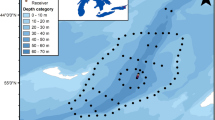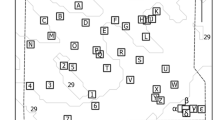Abstract
Understanding passive acoustic telemetry equipment limitations is critical for correctly interpreting movements of aquatic animals. Range test studies have been performed to determine what environmental factors may interfere with acoustic equipment efficiency. Many of these studies have been performed on shallow coral reef environments for a few days to weeks. This study examined environmental factors that influence detection variability on a mesophotic coral reef south of St. Thomas, United States Virgin Islands (−64.96°, 18.19°). Data from a stationary transmitter were examined against numerous environmental variables from June to September 2011. A generalized linear model was used to examine the daily detection proportion response to eight different environmental variables. Factors which had strong negative effects on detections received included when the current direction was flowing from receiver to transmitter, current speeds above 0.2 ms−1, a strong temperature gradient between transmitter and receiver, and increased water temperature. Detections varied throughout the different time periods of the day with sunset and sunrise having significantly lower detections than day, and sunset having significantly lower detections than night. The results highlight the importance of conducting a long-term range test and will aid design of future passive acoustic telemetry studies on mesophotic coral reefs.






Similar content being viewed by others
References
Au WW, Hastings MC (2008) Principles of marine bioacoustics. Springer, New York
Battista T, National Oceanic and Atmospheric Administration (2015) Water depth and acoustic backscatter data collected from NOAA Ship Nancy Foster in Caribbean Sea, South of St. John and St. Thomas and Buck Island, St. Croix, US Virgin Islands from 2005-02-01 to 2005-02-12 (NCEI Accession 0131860). Version 2.2. NOAA National Centers for Environmental Information. Dataset. Accessed 27 Sept 2016
Bertelsen RD, Hornbeck J (2009) Using acoustic tagging to determine adult spiny lobster (Panulirus argus) movement patterns in the western sambo ecological reserve Florida, United States. NZ J Mar Freshw Res 43:35–46
Biggs C, Nemeth RS (2016) Spatial and temporal movement patterns of two snapper species at multi-species spawning aggregation. Mar Ecol Prog Ser 558:129–142
Brockwell PJ, Davis RA (2002) Introduction to time series and forecasting, 2nd edn. Springer, New York
Cagua EF, Berumen ML, Tyler EHM (2013) Topography and biological noise determine acoustic detectability on coral reefs. Coral Reef 32:1123–1134
Cato DH (1978) Marine biological choruses observed in tropical waters near Australia. Acoust Soc Am 64:736–743
Cotton CF (2010) Factors affecting reception range of ultrasonic tags in a Georgia Estuary. Mar Technol Soc J 44:17–24
Dagorn L, Holland KN, Itano DG (2007) Behavior of yellowfin (Thunnus albacares) and bigeye (T. obesus) tuna in a network of fish aggregating devices (FADs). Mar Biol 151:595–606
How JR, de Lestang S (2012) Acoustic tracking: issues affecting design, analysis and interpretation of data from movement studies. Mar Freshw Res 63:312–324
Huveneers C, Simpfendorfer CA, Kim S, Semmens JM, Hobday AJ, Pederson H, Stieglitz T, Vallee R, Webber D, Heupel MR, Peddemors V (2016) The influence of environmental parameters on the performance and detection range of acoustic receivers. Methods Ecol Evol 7:825–835
Kaplan MB, Mooney TA, Partan J, Solow AR (2015) Coral reef species assemblages are associated with ambient soundscapes. Mar Ecol Prog Ser 533:93–107
Kessel ST, Cooke SJ, Heupel MR, Hussey NE, Simpfendorfer CA, Vagle S, Fisk AT (2013) A review of detection range testing in aquatic passive acoustic telemetry studies. Rev Fish Biol Fish 24:199–218
Mathies NH, Ogburn MB, McFall G, Fangman S (2014) Environmental interference factors affecting detection range in acoustic telemetry studies using fixed receiver arrays. Mar Ecol Prog Ser 495:27–38
Myers R (1994) Classical and modern regression with applications, 2nd edn. PWS-KENT, Boston
Nemeth RS (2012) Ecosystem aspects of species that aggregate to spawn. In: Sadovy Y, Colin PL (eds) Reef fish spawning aggregations: biology, research and management. Springer, Amsterdam, pp 21–55
Payne NL, Gillanders BM, Webber DM, Semmens JM (2010) Interpreting diel activity patterns from acoustic telemetry: the need for controls. Mar Ecol Prog Ser 419:295–301
Pickard AE, Vaudo JJ, Wetherbee BM, Nemeth RS, Blondeau JB, Kadison EA, Shivji MS (2016) Comparative use of a Caribbean mesophotic reef and of interactions with fish spawning aggregations for three species of shark. PLoS One 11:e0151221
Preisig JC (2005) Performance analysis of adaptive equalization for coherent acoustic communications in the time-varying ocean environment. J Acoust Soc Am 118:263–278
Preisig J (2007) Acoustic propagation considerations for underwater acoustic communications network development. ACM SIGMOBILE Mob Comput and Commun Rev 11:2–10
Radford CA, Jeffs AG, Tindle CT, Montgomery JC (2008) Temporal patterns in ambient noise of biological origin from a shallow water temperate reef. Oecologia 156:921–929
Rhodes KL, Nemeth RS, Kadison E, Joseph E (2014) Spatial, temporal and environmental dynamics of a multi-species epinephelid spawning aggregation in Pohnpei, Micronesia. Coral Reef 33:765–775
Rowell TJ, Nemeth RS, Appeldoorn RS, Schärer MT (2015) Fish sound production and acoustic telemetry reveal behaviors and spatial patterns associated with spawning aggregations of two Caribbean groupers. Mar Ecol Prog Ser 518:239–254
Schielzeth H (2010) Simple means to improve the interpretability of regression coefficients. Methods Ecol Evol 1:103–113
Selby T, Hart K, Fujisaki I, Smith B, Pollock C, Hillis-Starr Z, Lundgren I, Oli M (2016) Can you hear me now? Range-testing a submerged passive acoustic receiver array in a Caribbean coral reef habitat. Ecol Evol 6:4823–4835
Shroyer SM, Logsdon DE (2009) Detection distances of selected radio and acoustic tags in Minnesota lakes and rivers. North Am J Fish Manag 29:876–884
Siderius M, Porter MB, Hursky P, McDonald V (2007) Effects of ocean thermocline variability on noncoherent underwater acoustic communications. Acoust Soc Am 121:1895–1908
Siegel S, Castellan NJ Jr (1988) Non parametric statistics for the behavioural sciences. MacGraw-Hill, New York
Singh L, Downey NJ, Roberts MJ, Webber DM, Smale MJ, Van den Berg MA, Harding RT, Engelbrecht DC, Blows BM (2009) Design and calibration of an acoustic telemetry system subject to upwelling events. Afr J Mar Sci 31:355–364
Smith T, Blondeau J, Nemeth R, Pittman S, Calnan J, Kadison E, Grass J (2010) Benthic structure and cryptic mortality in a Caribbean mesophotic coral reef bank system, the Hind Bank Marine Conservation District, US Virgin Islands. Coral Reef 29:289–308
Staaterman E, Rice AN, Mann DA, Paris CB (2013) Soundscapes from a tropical eastern Pacific reef and a Caribbean Sea reef. Coral Reef 32:553–557
Staaterman E, Paris CB, DeFerrari HA, Mann DA, Rice AN, D’Alessandro EK (2014) Celestial patterns in marine soundscapes. Mar Ecol Prog Ser 508:17–32
Starr RM, Heine JN, Johnson KA (2000) Techniques for tagging and tracking deepwater rockfishes. N Am J Fish Manag 20:597–609
Stocks JR, Gray CA, Taylor MD (2014) Testing the effects of near-shore environmental variables on acoustic detections: implications on telemetry array design and data interpretation. Mar Technol Soc J 48:28–35
R Core Team (2016) R: a language and environment for statistical computing. R Foundation for Statistical Computing, Vienna, Austria. http://www.R-project.org/. Accessed 13 Oct 2016
Urick RJ (1983) Principles of underwater sound for engineers, 3rd edn. McGraw-Hill, New York
Vemco (2014) Vemco range test, software version 1.9.22.0. Amirax Systems, Bedford, Nova Scotia, CA
Welsh JQ, Fox RJ, Webber DM, Bellwood DF (2012) Performance of remote acoustic receivers within a coral reef habitat: implications for array design. Coral Reef 31:693–702
Acknowledgements
We thank Dr. Tyler Smith for providing long-term temperature and current data. Funding for the acoustic array was provided by the following Grants: Puerto Rico Sea Grant (#R-31-1-06), NOAA Saltonstall-Kennedy Program (#NA09NMF4270068), Virgin Islands Experimental Program to Stimulate Competitive Research (VI-EPSCoR #NSF-814417) and the Guy Harvey Research Institute. The Lana Vento Charitable Trust provided funds for research materials. Two reviewers provided excellent comments regarding the data analysis and interpretation of results. This is contribution number 177 to the University of the Virgin Islands Center for Marine and Environmental Studies.
Author information
Authors and Affiliations
Corresponding author
Ethics declarations
Conflict of interest
No conflict of interests are declared.
Additional information
Responsible Editor: J. D. R. Houghton.
Reviewed by S. de Lestang and an undisclosed expert.
Rights and permissions
About this article
Cite this article
Jossart, J., Nemeth, R.S., Primack, A. et al. Extreme passive acoustic telemetry detection variability on a mesophotic coral reef, United States Virgin Islands. Mar Biol 164, 180 (2017). https://doi.org/10.1007/s00227-017-3213-y
Received:
Accepted:
Published:
DOI: https://doi.org/10.1007/s00227-017-3213-y




